Leelanau Peat taking Mammoth Single Malt to the next level!
 The Leelanau Ticker shares that Mammoth Distilling’s special ingredient to take its spirits to the next level comes from right here in Leelanau:
The Leelanau Ticker shares that Mammoth Distilling’s special ingredient to take its spirits to the next level comes from right here in Leelanau:
Mammoth didn’t get its start in Leelanau; the company launched in 2013 with its original location in Central Lake. It also still doesn’t count a single Leelanau location among its six tasting rooms – though, tells the Leelanau Ticker that the distillery has been eyeing a Leelanau spot for its next outpost.
But what Mammoth Distilling lacks for roots or on-the-ground retail presence in Leelanau, (Mammoth Founder and CEO Chad) Munger says the distillery makes up for in terms of sheer agricultural loyalty. Famously, Mammoth has been pursuing a high-profile farming project for years out on South Manitou Island, with hopes of reviving a long-dormant strain of rye. The business also sources the vast majority of the grain for its whiskeys and other spirits from Leelanau’s own Empire Malting Company.
With Mammoth’s latest spirit, Munger says the company leaned on Leelanau County even more than usual. The result is something he describes as “the most Michigan product we have ever made.”
The product in question is Mammoth’s first-ever single malt whiskey, which the distillery officially debuted last month. Called Northern Single Malt Whiskey, the spirit uses not just 100 percent Conlon barley grown at Empire Malting, but also “peat harvested from a bog near Empire, Michigan.”
According to Munger, Alison Babb – the founder and director of Empire Malting – “has a handful of locations around northern Michigan where she harvests peat from bogs.” That peat is then used to smoke the barley, which Mammoth’s distillers in turn use to make whiskey. Munger says he “isn’t aware of anybody else that harvests Michigan peat,” which he also pinpoints as the key ingredient in Mammoth’s first-ever venture into the single malt space.
“It’s the peat that really distinguishes American single malt from scotch,” Munger explains. “So, single malt scotch, being the product everybody loves, is defined almost entirely by the character of the iodine that you find in peat that is near saltwater. Any peat harvested near the ocean is going to have saltwater, and that saltwater imparts iodine into the peat.”
The iodine in Scottish peat, in other words, is what gives traditional single malt scotch its unique flavor – a flavor Munger jokingly describes as “that kind of essence of band-aids that people either love or hate.” The iodine factor is also why American distilleries – particularly those based far away from saltwater areas – can’t even come close to replicating the taste and character of scotch.
Lots more in the Ticker & check out Mammoth Distilling on their website. Love it when the old ways of doing things still work!


